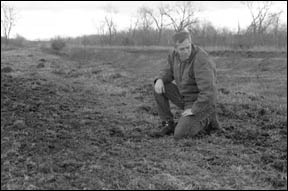 This summer a grassland east of Roscoe was set on fire intentionally. The Department of Natural Resources (DNR) set the well-monitored fire as part of a prairie restoration project.
This summer a grassland east of Roscoe was set on fire intentionally. The Department of Natural Resources (DNR) set the well-monitored fire as part of a prairie restoration project.According to Trygve Hanson (pictured at rightat the prairie), DNR technician, upland prairies used to blow freely in the wind on land near Roscoe in the early 1800s. Then the fertile prairie became prime agricultural land. Today, natural prairie land is extremely scarce in Stearns County.
The 30-acre site is located about one mile east of Roscoe along the former Burlington Northern Railroad track.
The DNR purchased 36 miles of former railroad land from Burlington Northern in 1994. The area extends from Willmar to Richmond. The former railroad was renamed Glacial Lakes State Trail. The trail is paved from Willmar to New London and has a crushed rock base from New London to the Stearns County line.
Fourteen miles of the trail is located in Stearns County but it has never been developed.
Last summer Prairie Restoration, Inc. did a plant survey on a section of the trail. This summer they took the first steps to re-establish a native prairie community. They mowed and treated the site on both sides of the trail with a herbicide to eliminate existing vegetation, which was primarily nonnative plants. Just before reseeding, the dead vegetation was burned off.
Once the area was burned, it was lightly disked and then seeded to native wildflowers and grasses. The area had been farmed for many years by farmers adjacent to the trail.
According to Hanson, there were more than 33 species of wildflowers in the seed mixture. "We try to mix native prairie wildflowers which existed out here in the 1800s," Hanson said.
People won't see much difference in the area for the first year or two. During that period all the plant's energy is directed to the root system. During the third year, the roots are set and the field should be full of blooms, he added.
"At present, we are not managing the area for active use," Hanson said. The DNR's goal includes prairie restoration, developing natural plant use, and contacting area schools to see if they are interested in using the area for educational purposes.
"The more diversity the better the ecological value. We can't reconstruct the original prairie, but we can restore some of the native plants," Hanson said.
"This area is an excellent opportunity to not only restore a prairie but to inform trail users about natural plant communities and demonstrate the process of re-establishment along with future management activities," Angela Anderson, natural communities management coordinator for DNR, said.
Funds for this project were allocated by the legislative committee on Minnesota Resources to DNR's Trails and Waterways natural communities management program.
The DNR is hoping that someday a grass-roots effort will promote the development of the trail to Richmond and eventually to St. Cloud.
Besides the restoration project east of Roscoe, last year the DNR burned an area near Bork Lumber and Steel north of Paynesville on another section of the trail.